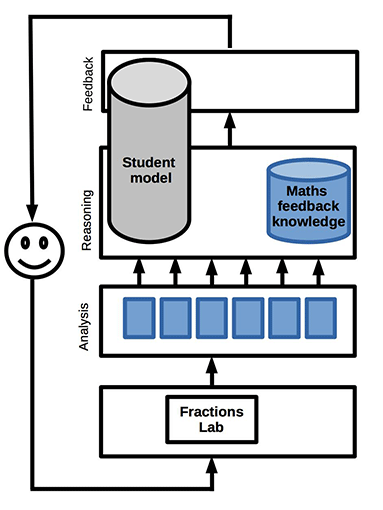The aim of WP2 is to provide the iTalk2learn platform with intelligence that can guide students to maths mastery. But how can we make a machine intelligent?
In order to answer the question, ‘how can we make a machine intelligent?’, we must first divide the problem into sub-problems. In the iTalk2Learn project, each sub-problem corresponds to a different component of the iTalk2Learn platform. Each of these components are combined in a complementary manner, to form the coordinating platform and a seemingly unique intelligence.
The components/problem solvers of the iTalk2Learn platform are:
- The performance predictor
- The sequencer
- Adaptive task-dependent support
- Adaptive task-independent support
- The switcher
1. The performance predictor
The aim of the performance predictor is to predict the mark a student might achieve in a specific task. In iTalk2Learn, we use domain agnostic performance predictors, which are based upon matrix factorisation methods developed by the University of Hildesheim [6-9].
We use these predictors in a novel way. Although they are currently used for sequencing, they will soon be used to steer other intervention methods, such as switchers and hint sequencers [3].
2. The sequencer
One of our goals is to take the state-of-the-art in sequencing educational content further. All the while, we must achieve a solution that both relies on data rather than on expertise and is not over reliant on data collection modalities and students’ effort.
In “Adaptive Content Sequencing without Domain Information” [1], we showed how a score prediction method and a simple policy, inspired by Vygotsky’s concept of Proximal Development, could be used to ameliorate sequencing in a simulated environment. For this reason, the sequencer prototype is called the Vygotsky Policy Sequencer (VPS).

Experts select a target mark that students should receive in an exercise. This mark that should be neither too high nor low, in order to avoid both boredom and frustration for the student. The VPS selects the next task according to the predictions of the performance predictor – the student receives the task that is deemed most appropriate according to the predicted and target marks.
The feasibility of such a sequencer was discussed at the Education Data Mining Conference with the most important researchers of the area [3]. The VPS does not require authoring effort. It allows easier integration of sequencers into an already existing ITS supporting our current work at the iTalk2Learn project that aims to incorporate contents from different systems into an open architecture [2].
We recently discussed the feasibility of such a sequencer with fellow experts at the Education Data Mining Conference [3]. The VPS does not require authoring effort. Instead, it allows easier integration of sequencers into an already existing ITS (supporting our current work at the iTalk2Learn project, which aims to incorporate contents from different systems into an open architecture) [2].
The results of a user study showed that the sequencer is able to both sequence tasks in a reasonable way and model user knowledge accurately (see Deliverable 2.2.1 and Deliverable 5.2).
As a next step, we will discuss and investigate how different features (extracted from speech input for affect recognition) could be used to support our sequencer. This could be done in a number of ways [10-11]: the feature values or the affect recognition output could, for instance:
- interact with the matrix factorisation based algorithms to ameliorate the performance prediction
- be used to further personalise the VPS by adapting the target mark, or
- be used to support the sequencing of tasks by creating rules which indicate if the next task should be easier, harder or of similar difficulty.
3. Adaptive task-dependent support
The task-dependent support, developed by Birbeck College, consists of three main layers:
- the analysis or evidence detection layer
- the reasoning layer
- the feedback generation layer
In the evidence detection layer, the student’s interactions with Fractions Lab are detected. Based on the evidence detection component, the reasoning layer decides which concept(s) or aspects need support. This layer includes the maths feedback knowledge and the student model. The maths feedback knowledge base includes rules on how to feedback or support should be provided based upon the student’s interaction with Fractions Lab.
We developed an ontology for representing the feedback rules (which are based on a knowledge representation language). This provides an easy way to add and refine feedback rules for particular exploratory tasks. The student model includes knowledge about the maths domain as well as knowledge about common misconceptions associated with the particular task. The model receives data about the student’s actions from the analysis layer, which is then mapped to the maths knowledge and the misconceptions. The student model also includes information about the reasoning stages, including the current reasoning stage.
This information is then used by the reasoning layer to provide personalised adaptive support, which is based on his/her knowledge (and misconceptions) of the task at the current reasoning stage. The feedback generation layer receives the output from the reasoning layer to decide how the support should be presented (for example, with high or low intrusion feedback).
4. Adaptive task-independent support
In order for students to communicate more naturally with the interface, speech recognition for children is integrated into the platform. The aim of the task-independent support is to use the children’s speech to provide feedback on structured and unstructured tasks, according to their mathematical vocabulary and their affective states.
In “Interventions During Student Multimodal Learning Activities: which, and why?” [4], we showed that, for certain types of affective states, particular feedback types are more effective than others. We also investigated which types of feedback presentation are more effective for particular affective states [5].
5. The switcher
We see switching between exploratory and structured tasks as an extension of sequencing of structured tasks only. Therefore, it will be developed as part of WP2 in year 3. D1.3 (the WP1 deliverable on iTalk2Learn’s Intervention models) explains how this can be done in a rule-based way, exploiting the components aforementioned.
For instance, if a student has completed an exploratory task of a specific difficulty, they would usually proceed with structured tasks,. However, the performance predictor may instead inform the platform that the student will not pass any of the structured tasks. As a result, instead of frustrating the child with unfruitful practice, another exploratory task is suggested, back by further more support.
Want to know more?
If you’re interested in knowing more about the intelligence behind the iTalk2Learn platform, please read Deliverable 2.2.1 and take a look at our papers.
References:
[1] Schatten C. and Schmidt-Thieme, L. (2014) Adaptive content sequencing without domain information. In proceedings of CSEDU 2014.
[2] Schatten C., Wistuba M., Schmidt-Thieme, L. and Gutiérrez-Santos S. (2014) Minimal Invasive Integration of Learning Analytics Services in Intelligent Tutoring Systems, 14th IEEE International Conference on Advanced Learning Technologies – ICALT2014.
[3] Schatten, C., Janning, R., Mavrikis, M., Schmidt-Thieme, L., (2014c) Matrix Factorization Feasibility for Sequencing and Adaptive Support in ITS, 7th International Conference on Educational Data Mining EDM 2014
[4] Grawemeyer, B., Mavrikis, M., Gutierrez-Santos, S., Hansen, A. (2014a). Interventions During Student Multimodal Learning Activities: which, and why?. Proceedings of FFMI workshop at EDM.
[5] Grawemeyer, B., Mavrikis, M., Hansen, A., Mazziotti, C., Gutierrez-Santos, S. (2014b). Employing Speech to Contribute to Modelling and Adapting to Students’ Affective States. Proceedings of EC-TEL.
[6] Thai-Nghe, N., Drumond, L., Krohn-Grimberghe, A., Schmidt-Thieme, L. (2010) Recommender system for predicting student performance. In Procedia Computer Science, 1(2), 2811-2819.
[7] Thai-Nghe, N., Drumond, L., Horvath, T., Krohn-Grimberghe, A., Nanopoulos, A., Schmidt-Thieme, L. (2011) Factorization techniques for predicting student performance. In Educational Recommender Systems and Technologies: Practices and Challenges. IGI Global (2011).
[8] Thai-Nghe, N., Drumond, L., Horvath, T., Nanopoulos, A., Schmidt-Thieme, L. (20100) Matrix and Tensor Factorization for Predicting Student Performance. In CSEDU (1).
[9] Thai-Nghe, N., Horváth, T., Schmidt-Thieme, L. (2011) Personalized forecasting student performance. In Advanced Learning Technologies (ICALT), 2011 11th IEEE International Conference on. IEEE.
[10] Janning, R., Schatten, C. and Schmidt-Thieme, L. (2014b) Multimodal affect recognition for adaptive intelligent tutoring systems. Extended Proceedings of the 7th International Conference on Educational Data Mining (EDM 2014), 171–178.
[11] Janning, R., Schatten, C. and Schmidt-Thieme, L. (2014c) Feature analysis for affect recognition supporting task sequencing in adaptive intelligent tutoring systems. Proceedings of the European Conference on Technology Enhanced Learning (EC-TEL 2014), 179–192.


